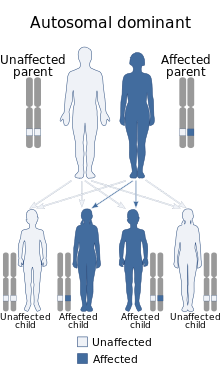Familial male-limited precocious puberty
Familial male-limited precocious puberty, often abbreviated as FMPP, also known as familial sexual precocity or gonadotropin-independent testotoxicosis,[1] is a form of gonadotropin-independent precocious puberty in which boys experience early onset and progression of puberty.[2] Signs of puberty can develop as early as an age of 1 year.[citation needed]
| Familial male-limited precocious puberty | |
|---|---|
| Other names | Familial sexual precocity |
 | |
| Male-limited precocious puberty has an autosomal dominant pattern of inheritance. However, only males are affected; females with the mutant gene are not affected. | |
The spinal length in boys may be short due to a rapid advance in epiphyseal maturation. It is an autosomal dominant[1] condition with a mutation of the luteinizing hormone (LH) receptor. As FMPP is a gonadotropin-independent form of precocious puberty, gonadotropin-releasing hormone agonists (GnRH agonists) are ineffective. Treatment is with drugs that suppress or block the effects of gonadal steroidogenesis, such as cyproterone acetate, ketoconazole, spironolactone, and testolactone.[3] Alternatively, the combination of the androgen receptor antagonist bicalutamide and the aromatase inhibitor anastrozole may be used.[4]
Robert King Stone, personal physician to American president Abraham Lincoln, described the first case of FMPP in 1852.[5]
See also
editReferences
edit- ^ a b Online Mendelian Inheritance in Man (OMIM): 176410
- ^ Traggiai C, Stanhope R (2003). "Disorders of pubertal development". Best Pract Res Clin Obstet Gynaecol. 17 (1): 41–56. doi:10.1053/ybeog.2003.0360. PMID 12758225.
- ^ Reiter EO, Norjavaara E (2005). "Testotoxicosis: current viewpoint". Pediatr Endocrinol Rev. 3 (2): 77–86. PMID 16361981.
- ^ Kreher NC, Pescovitz OH, Delameter P, Tiulpakov A, Hochberg Z (Sep 2006). "Treatment of familial male-limited precocious puberty with bicalutamide and anastrozole". The Journal of Pediatrics. 149 (3): 416–20. doi:10.1016/j.jpeds.2006.04.027. PMID 16939760.
- ^ Tao, Ya-Xiong (November 2008). "Constitutive activation of G protein-coupled receptors and diseases: Insights into mechanisms of activation and therapeutics". Pharmacology & Therapeutics. 120 (2). Elsevier: 129–148. doi:10.1016/j.pharmthera.2008.07.005. PMC 2668812. PMID 18768149.
External links
edit- Testotoxicosis at NIH's Office of Rare Diseases